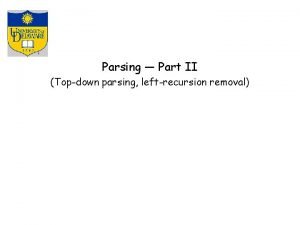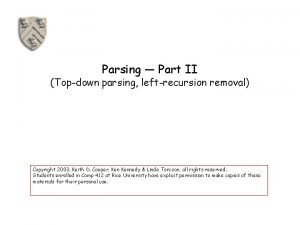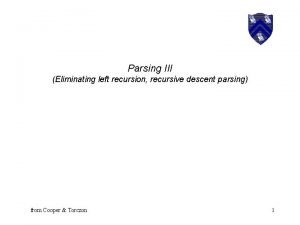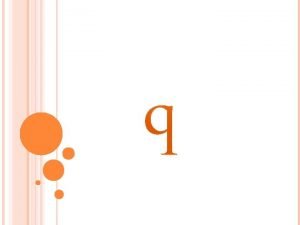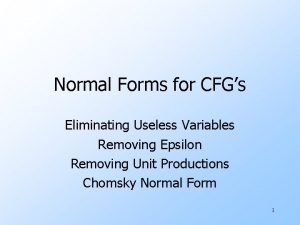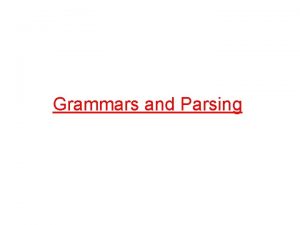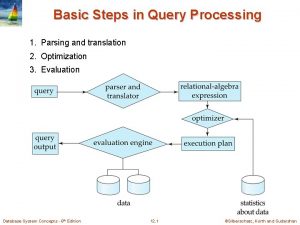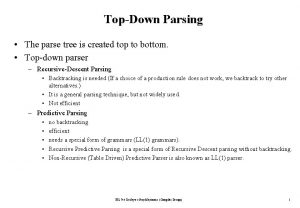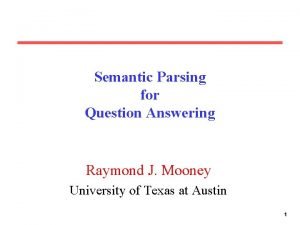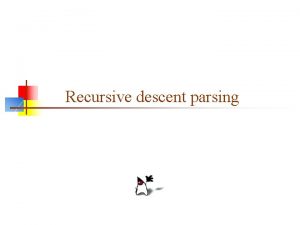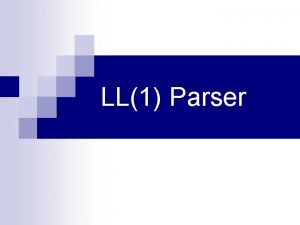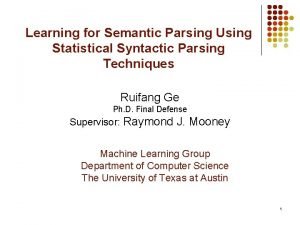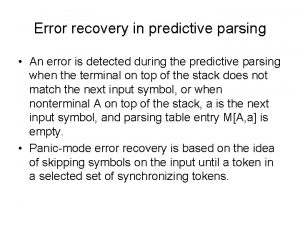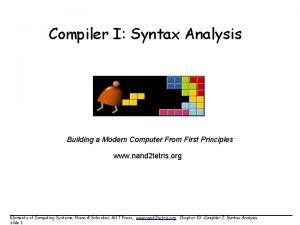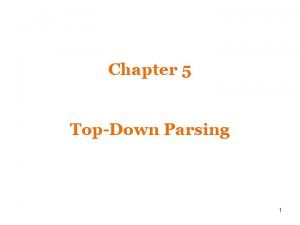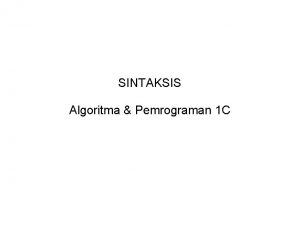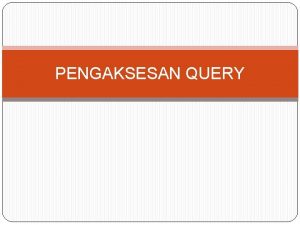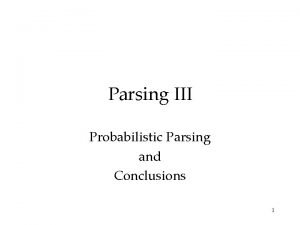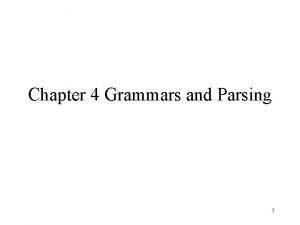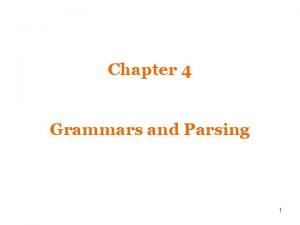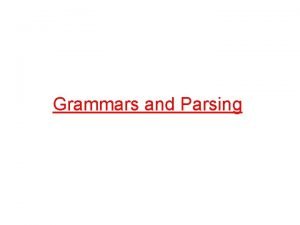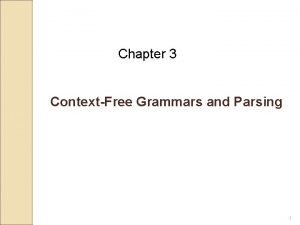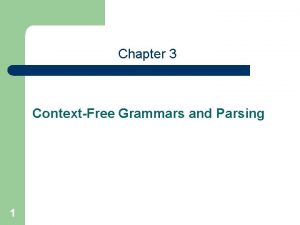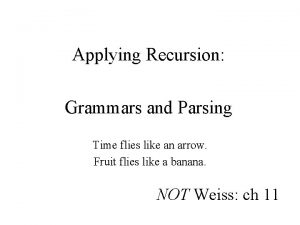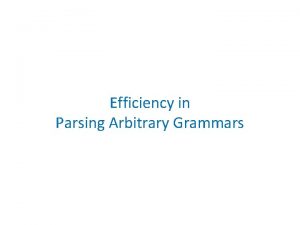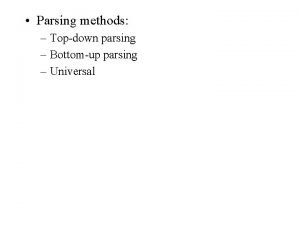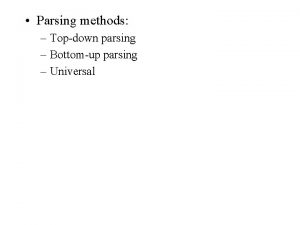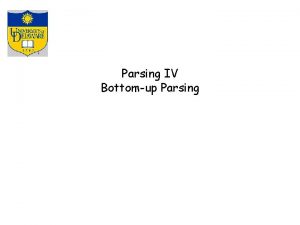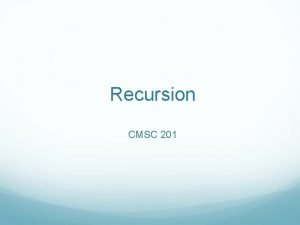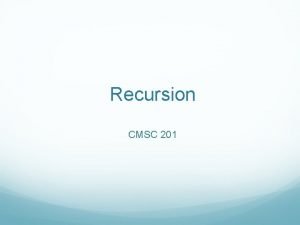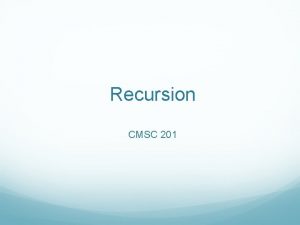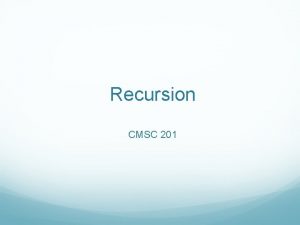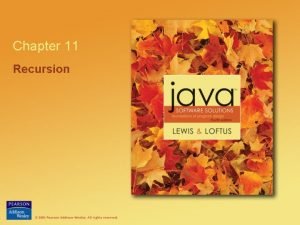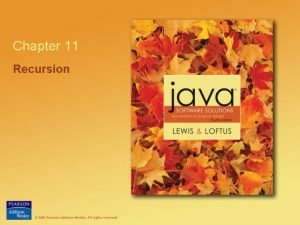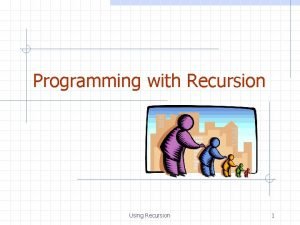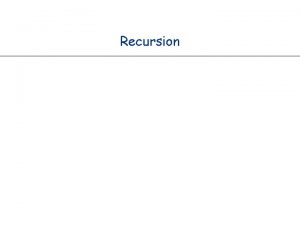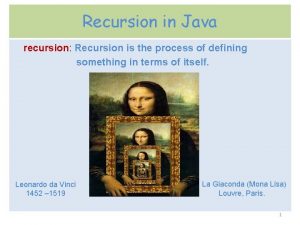Grammars and Parsing Application of Recursion So far



























- Slides: 27

Grammars and Parsing

Application of Recursion • So far, we have written recursive programs on integers: factorial, fibonacci, permutations, an • Let us now consider a new application, grammars and parsing, that shows off the full power of recursion. • Parsing has numerous applications: compilers, data retrieval, data mining, ….

Motivation The cat ate the rat slowly. The small cat ate the big rat on the mat slowly. The small cat that sat in the hat ate the big rat on the mat slowly, then got sick. … – Not all sequences of words are legal sentences • The ate cat rat the – How many legal sentences are there? – How many legal programs are there? – Are all Java programs that compile legal programs? – How do we know what programs are legal? – http: //java. sun. com/docs/books/jls/first_edition/html/19. doc. html

Grammars Sentence Noun Verb => Noun Verb Noun => boys => girls => dogs => like => see • Grammar: set of rules for generating sentences in a language. • Our sample grammar has these rules: – a Sentence can be a Noun followed by a Verb followed by a Noun – a Noun can be ‘boys’ or ‘girls’ or ‘dogs’ – a Verb can be ‘like’ or ‘see’ • Examples of Sentence: – boys see dogs – dogs like girls – …. . • • Note: white space between words does not matter This is a very boring grammar because the set of Sentences is finite (exactly 18 sentences).

Recursive Grammar Sentence Noun Verb => Sentence and Sentence => Sentence or Sentence => Noun Verb Noun => boys => girls => dogs => like => see • Examples of Sentences in this language: – – – boys like girls and girls like dogs and girls like dogs ……… • This grammar is more interesting than the one in the last slide because the set of Sentences is infinite. • What makes this set infinite? Answer: recursive definition of Sentence

Grammar Subtleties • What if we want to add a period at the end of every sentence? Sentence => Sentence and Sentence => Sentence or Sentence => Noun Verb Noun => ……. . • Does this work? • No! This produces sentences like: girls like boys. and boys like dogs. .

Sentences with Periods. Top. Level. Sentence => Sentence and Sentence => Sentence or Sentence => Noun Verb Noun => boys Noun => girls Noun => dogs Verb => like Verb => see • Add a new rule that adds a period only at the end of the sentence. • Thought exercise: how does this work?

Grammar for Simple Expressions Expression => integer Expression => ( Expression + Expression ) • This is a grammar for simple expressions: – An E can be an integer. – An E can be ‘(‘ followed by an E followed by ‘+’ followed by an E followed by ‘)’ • Set of Expressions defined by this grammar is a recursively-defined set. • Is language finite or infinite? • Do recursive grammars always yield infinite languages?

E => integer E => (E + E) • Here are some legal expressions: 2 (3 + 34) ((4+23) + 89) ((89 + 23) + (23 + (34+12))) • Here are some illegal expressions: (3 3+4 • Each legal expression can be parsed into a parse tree.

Parsing • Parsing: given a grammar and some text, determine if text is a legal sentence in the language defined by that grammar • For many grammars (e. g. the simple expression grammar), we can write efficient programs to answer this question. • Next slides: parser for our small expression language – Caveat: code uses CS 211 In object for doing input from a file. – Goal: understand the structure of the code to see the parallel between the language definition (recursive set) and the parser (recursive function)

Helper class: CS 211 In • On-line code for the CS 211 In class • Code lets you – open file for input: • CS 211 In f = new CS 211 In(String-for-file-name) – examine what the next thing in file is: f. peek. At. Kind() • Integer? : such as 3, -34, 46 • Word? : such as x, r 45, y 78 z (variable name in Java) • Operator? : such as +, -, *, ( , ) , etc. – read next thing from file: • integer: f. get. Int() • Word: f. get. Word() • Operator: f. get. Op()

• Useful methods in CS 211 In class: – f. check(char c): • Example: f. check(‘*’); //true if next thing in input is * • Check if next thing in input is c – If so, eat it up and return true – Otherwise, return false – f. check(String s): • Example of its use: f. check(“if”); – Return true if next thing in input is word if

Parser for expression language static boolean exp. Parser(String file. Name) {//returns true if file has single expression CS 211 In f = new CS 211 In(file. Name); boolean got. It = get. Exp(f); if (f. peek. At. Kind() == CS 211 In. EOF) //no junk in file after expression return got. It; else //file contains some junk after expression, so return false; } static boolean get. Exp(CS 211 In f) {//reads one expression from file //defined on next slide }

Parser for Expression Language static boolean exp. Parser(String file. Name) {//returns true if file has single expression //defined on previous slide } static boolean get. Exp(CS 211 In f) {//reads one expression from file switch (f. peek. At. Kind()) { case CS 211 In. INTEGER: {//E => integer f. get. Int(); return true; } case CS 211 In. OPERATOR: {//E => (E+E) return f. check(‘(‘) && get. Exp(f) && f. check(‘+’) && get. Exp(f ) && f. check(‘)’)); } default: return false; }//ends switch f. peek. At. Kind }

Note on Boolean Operators • Java supports two kinds of Boolean operators: – E 1 & E 2: • Evaluate both E 1 and E 2 and compute their conjunction (i. e. , “and”) – E 1 && E 2: • Evaluate E 1. If E 1 is false, E 2 is not evaluated, and value of expression is false. If E 1 is true, E 2 is evaluated, and value of expression is the conjunction of the values of E 1 and E 2. • In our parser code, we use && – if “f. check(‘(‘) returns false, we simply return false without trying to read anything more from input file. This gives a graceful way to handling errors. – don’t worry about this detail if it seems too abstruse…

Trace of Recursive Calls to get. Exp (3 + (34 + 23)) get. Exp( )

Modifying Parser to Generate Code for a Stack Machine • Let us modify the parser so that it generates stack code to evaluate arithmetic expressions: 2 : PUSH 2 STOP (2 + 3) : PUSH 2 PUSH 3 ADD STOP

Idea • Recursive method get. Exp should return a string containing stack code for expression it has parsed. • Top-level method exp. Parser should tack on a STOP command after code received from get. Exp. • Method get. Exp generates code in a recursive way: – For integer i, it returns string “PUSH” + i + “n” – For (E 1 + E 2), • recursive calls return code for E 1 and E 2 – say these are strings S 1 and S 2 • method returns S 1 + S 2 + “ADD”

Code. Gen for Expression language static String exp. Code. Gen(String file. Name) {//returns stack code for expression in file CS 211 In f = new CS 211 In(file. Name); String pgm = get. Exp(f); return pgm + “STOPn”; //not doing error checking to keep it simple } static String get. Exp(CS 211 In f) {//no error checking to keep it simple switch (f. peek. At. Kind()) { case CS 211 In. INTEGER: //E => integer return “PUSH” + f. get. Int() + “n”; case CS 211 In. OPERATOR: //E => (E+E) { f. check(‘(‘); String s 1 = get. Exp(f); f. check(‘+’); String s 2 = get. Exp(f); f. check(‘)’); return s 1 + s 2 + “ADDn”; } default: return “ERRORn”; } }

Trace of Recursive Calls to get. Exp PUSH 34 PUSH 23 ADD (3 + (34 + 23)) get. Exp( ) PUSH 34 PUSH 23 ADD PUSH 3 (3 + (34 + 23)) get. Exp( ) PUSH 34 (3 + (34 + 23)) get. Exp( ) PUSH 23 (3 + (34 + 23)) get. Exp( )

Exercises • Think about recursive calls made to parse and generate code for simple expressions • 2 • (2 + 3) • ((2 + 45) + (34 + -9)) • Can you derive an expression for the total number of calls made to get. Exp for parsing an expression? – Hint: think inductively • Can you derive an expression for the maximum number of recursive calls that are active at any time during the parsing of an expression?

Exercises • Write a grammar and recursive program for palindromes? – – – – mom dad i prefer pi race car red rum sir is murder for a jar of red rum sex at noon taxes • Write a grammar and recursive program for strings AN BN – AB – AABB – AAAAAAABBBBBBB • Write a grammar and recursive program for Java identifiers – <letter> [<letter> or <digit>]0…N – j 27, but not 2 j 7

Number of recursive calls • Claim: # of calls to get. Exp for expression E = # of integers in E + # of addition symbols in E. Example: ((2 + 3) + 5) # of calls to get. Exp = 3 + 2 = 5

Inductive Proof • Order expressions by their length (# of tokens) • E 1 < E 2 if length(E 1) < length(E 2). (2 + 3) 1 7 0 1 -2 (1 + 0) 2 3 4 5

Proof of # of recursive calls • Base case: (length = 1) Expression must be an integer. get. Exp will be called exactly once as predicted by formula. • Inductive case: Assume formula is true for all expressions with n or fewer tokens. – If there are no expressions with n+1 tokens, result is trivially true for n+1. – Otherwise, consider expression E of length n+1. E cannot be an integer; therefore it must be of the form (E 1 + E 2) where E 1 and E 2 have n or fewer tokens. By inductive assumption, result is true for E 1 and E 2. (contd. on next slide)

Proof(contd. ) #-of-calls-for-E = = 1 + #-of-calls-for-E 2 = 1 + #-of-integers-in-E 1 + #-of-'+'-in-E 1 + #-of-integers-in-E 2 + #-of-'+'-in-E 2 = #-of-integers-in-E + #-of-'+'-in-E as required.

Conclusion • Recursion is a very powerful technique for writing compact programs that do complex things. • Common mistakes: – Incorrect or missing base cases – Sub-problems must be simpler than top-level problem • Try to write description of recursive algorithm and reason about base cases etc. before writing code. – Why? – Syntactic junk such as type declarations … can create mental fog that obscures the underlying recursive algorithm. – Try to separate logic of program from coding details.
 Left recursion
Left recursion For top down parsing left recursion removal is
For top down parsing left recursion removal is Left factoring algorithm
Left factoring algorithm To understand recursion you must understand recursion
To understand recursion you must understand recursion Unrestricted grammar example
Unrestricted grammar example Handling questions in context-free grammars
Handling questions in context-free grammars Regular grammars generate regular languages
Regular grammars generate regular languages Eliminate useless symbols
Eliminate useless symbols Unrestricted grammar
Unrestricted grammar Far far from gusty waves figure of speech
Far far from gusty waves figure of speech Gusty waves indicate
Gusty waves indicate In a kingdom far far away
In a kingdom far far away Far far away city
Far far away city Application of recursion
Application of recursion Steps of query processing
Steps of query processing Recursive descent parsing
Recursive descent parsing Semantic parsing
Semantic parsing Recursive descent parser
Recursive descent parser Parsing in nlp
Parsing in nlp Ll1 grammar
Ll1 grammar Parsing syntax
Parsing syntax Panic mode error recovery in predictive parsing
Panic mode error recovery in predictive parsing Syntax analysis
Syntax analysis Recursive descent parsing
Recursive descent parsing Advantages of bottom up parsing
Advantages of bottom up parsing Yang memeriksa sintaks dan memeriksa relasi adalah
Yang memeriksa sintaks dan memeriksa relasi adalah Parsing adalah
Parsing adalah Probabilistic parsing
Probabilistic parsing
